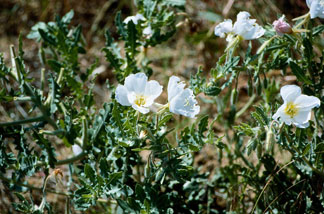ENGELMANN'S EVENING-PRIMROSE
|
 |
| File Size: 124 KB |
|
|
|
Oenothera engelmannii (Small ) Munz
|
| Morton County, Kansas (photo by Marion McGlohon) |
| Annual |
| Height: 8-30 inches |
| Family: Onagraceae - Evening-primrose Family |
| Flowering Period: May, June, July, August, September |
|
| Stems: | | Spreading to ascending or erect, branched below, villous; epidermis white or greenish white, exfoliating. | | Leaves: | | Basal and cauline, alternate; basal sometimes withering before flowering, blades 1 to 4.8 inches long, 1/6 to 1 inch wide, margins sinuate-dentate to pinnately lobed; cauline sometimes withering proximally, sessile or short-petiolate, blades oblong-lanceolate to lanceolate, 2/5 to 3.2 inches long, 1/12 to 4/5 inch wide, margins sinuate-dentate to coarsely dentate or pinnately lobed, surfaces glabrate or finely strigose. | | Inflorescences: | | Axillary, flowers solitary. | | Flowers: | | Radially symmetric; hypanthium 4/5 to 1.2 inch, pilose and finely strigose; sepals 4, deciduous, absent on fruit, reflexed, lanceolate, 2/5 to 4/5 inch, distinct at flowering; petals white, fading pink, 4, broadly obovate, 1/2 to 4/5 inch, tip rounded or slightly emarginate; stamens 8, anthers 1/6 to 1/4 inch; stigma positioned above anthers, deeply 4-lobed, lobes 1/12 to 1/7 inch. | | Fruits: | | Capsules, stiffly spreading, lanceoloid, 1 to 2 inches long, 1/25 to 1/7 inch wide, straight or slightly curved, 4-angled, finely strigose and with spreading hairs; seeds many per fruit, reddish brown, linear-obovoid, 1/25 to 1/15 inch, smooth or obscurely longitudinally striate. | | Habitat: | | Sandsage prairies | | Distribution: | | Southwest corner of Kansas | | Origin: | | Native | | Comments: | | Named for American botanist George Engelmann. |
|
| Engelmann's evening-primrose |  | | 191 KB | | Morton County, Kansas (photo by Marion McGlohon) |
| | | | |
|
|
|
|
|
|